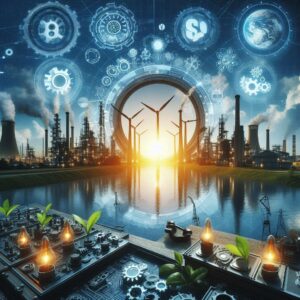Introduction As the world faces the growing challenges of climate change and dwindling fossil fuel reserves, the need for sustainable energy solutions has never been more urgent. Renewable energy sources, such as solar, wind, and hydroelectric power, offer a promising path to a cleaner and more sustainable future. In this article, we will explore the latest innovations in renewable energy and how they are shaping the future of energy production.

Solar Energy Innovations Solar energy is one of the most abundant and accessible renewable energy sources. Recent advancements in solar technology have significantly improved its efficiency and affordability.
- Perovskite Solar Cells: These new solar cells offer higher efficiency and lower production costs compared to traditional silicon-based cells.
- Floating Solar Farms: By installing solar panels on bodies of water, we can maximize space usage and reduce water evaporation.
- Solar-Powered Desalination: Using solar energy to desalinate seawater provides a sustainable solution to water scarcity.
Wind Energy Innovations Wind energy has seen remarkable growth in recent years, thanks to technological advancements that have made it more efficient and cost-effective.
- Offshore Wind Farms: These wind farms harness stronger and more consistent winds found at sea, providing a reliable energy source.
- Vertical Axis Wind Turbines: These turbines can capture wind from any direction, making them suitable for urban environments.
- Wind-Powered Hydrogen Production: Wind energy can be used to produce hydrogen, a clean and versatile fuel for various applications.
Hydroelectric Energy Innovations Hydroelectric power is a well-established renewable energy source, and recent innovations have further enhanced its potential.
- Pumped-Storage Hydropower: This technology stores excess energy by pumping water to higher elevations, which can be released to generate electricity when needed.
- Small-Scale Hydropower: Developing small hydro plants in rivers and streams can provide localized and sustainable energy solutions.
- Marine Energy: Tidal and wave energy technologies harness the power of the ocean to generate electricity.
The Role of Smart Grids Smart grids are essential for integrating renewable energy sources into the existing energy infrastructure. These advanced grids use digital technology to monitor and manage energy flows, ensuring a reliable and efficient distribution of power.
- Energy Storage Systems: Innovations in battery technology, such as lithium-ion and solid-state batteries, enable the storage of excess renewable energy for later use.
- Demand Response Programs: These programs incentivize consumers to reduce energy usage during peak times, balancing supply and demand.
- Grid Modernization: Upgrading the electrical grid with smart technologies ensures a more resilient and adaptable energy system.
Conclusion The future of energy lies in sustainable and renewable solutions. Innovations in solar, wind, and hydroelectric power, along with advancements in smart grid technology, are paving the way for a cleaner and more sustainable energy landscape. By embracing these innovations, we can reduce our reliance on fossil fuels and create a brighter future for generations to come.
